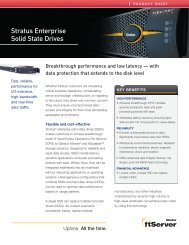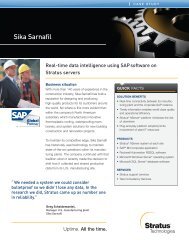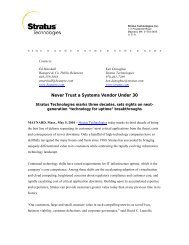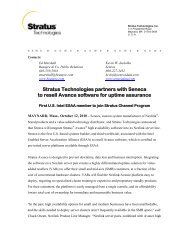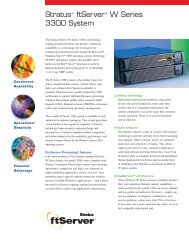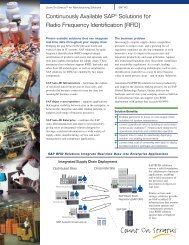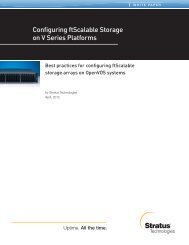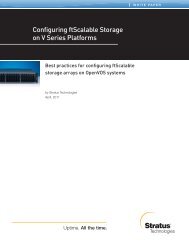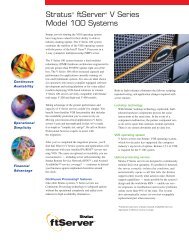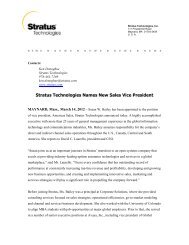Securing the VOS Telnet Daemon
Securing the VOS Telnet Daemon
Securing the VOS Telnet Daemon
You also want an ePaper? Increase the reach of your titles
YUMPU automatically turns print PDFs into web optimized ePapers that Google loves.
<strong>Securing</strong> <strong>the</strong> <strong>VOS</strong> <strong>Telnet</strong> <strong>Daemon</strong><br />
Noah Davids<br />
Stratus Customer Assistance Center<br />
May 23, 2012
<strong>Securing</strong> <strong>the</strong> <strong>VOS</strong> <strong>Telnet</strong> <strong>Daemon</strong><br />
� Background – Why is <strong>the</strong> <strong>Telnet</strong> daemon still needed<br />
� Restricting connections with TCP Wrappers<br />
� Selective listening with –local_ip<br />
� Using SSH tunnels<br />
� Using IPSec<br />
� What not to do<br />
2
Background – why is <strong>the</strong> <strong>Telnet</strong><br />
daemon still needed<br />
� Running telnetd is required for<br />
• RSN<br />
� Incoming slave<br />
• Remote printing<br />
� Outgoing slave<br />
• If you don’t use telnetd for your own connections you can<br />
remove <strong>the</strong> telnet line from <strong>the</strong> telnetservice file<br />
• If you don’t use telnetd for your own connections and you<br />
don’t want RSN support you can remove both <strong>the</strong> telnet and<br />
rsn_incoming lines from <strong>the</strong> telnetservice file<br />
• If you don’t use telnetd for your own connections and don’t<br />
want RSN support and don’t do remote printing <strong>the</strong>n you can<br />
stop running telnetd<br />
3
Restricting connections with TCP<br />
Wrappers<br />
� Start telnet with <strong>the</strong> –tcpwrapper_check and –<br />
numeric arguments set to yes.<br />
� Set up <strong>the</strong> hosts.allow and hosts.deny files in<br />
>system>stcp<br />
� Format is<br />
• >system>stcp>command_library>telnetd.pm : IP-ADDR1 IP-<br />
ADDR2 IP-ADDR3 IP-ADDR4/MASK<br />
• See http://stratadoc.stratus.com/vos/17.1.0/r419-<br />
10/wwhelp/wwhimpl/js/html/wwhelp.htm?context=r419-<br />
10&file=ch5r419-10l.html for alternative formats<br />
4
Restricting connections with TCP<br />
Wrappers<br />
� Addresses in <strong>the</strong> hosts.allow file are allowed to<br />
complete <strong>the</strong> login process<br />
� Addresses in <strong>the</strong> hosts.deny file are disconnected<br />
� Addresses in nei<strong>the</strong>r file are allowed to complete <strong>the</strong><br />
login process<br />
• This line in <strong>the</strong> hosts.deny will prevent any logins except those<br />
in <strong>the</strong> hosts.allow file<br />
� >system>stcp>command_library>telnetd.pm : ALL<br />
� Changes in <strong>the</strong> hosts.allow and hosts.deny file take<br />
place immediately – no need to restart telnetd<br />
� Changes will not effect connections already logged in<br />
5
Restricting connections with TCP<br />
Wrappers<br />
� Users that are denied will get connected and <strong>the</strong>n<br />
disconnected<br />
• What <strong>the</strong>y see will depend on <strong>the</strong>ir telnet client<br />
• Scanning programs will note that something is listening on <strong>the</strong><br />
port since a TCP connection completes before <strong>the</strong> disconnect<br />
� >system>stcp>logs>tcpddeny file will list all denied<br />
connections<br />
• 12-04-25 15:42:11 mst telnetd: refused connect from myworkstation.stratus.com<br />
� Note <strong>the</strong> double “d” in <strong>the</strong> tcpddeny name<br />
� >system>stcp>logs>tcpdallow file will list all allowed<br />
connections<br />
• 12-04-25 15:08:58 mst telnetd: connect from yourworkstation.stratus.com<br />
6
Restricting connections with TCP<br />
Wrappers<br />
� The hosts.allow and deny files are for all ports that<br />
telnetd is listening for<br />
• You cannot have a separate set for 1 port and a different set<br />
for ano<strong>the</strong>r<br />
7
Restricting connections with TCP<br />
Wrappers<br />
� The default telnetservice file listens for both <strong>the</strong><br />
telnet service (port 23) and <strong>the</strong> rsn_incoming service<br />
(port 85)<br />
telnet window_term "keepalive nodelay " "Default login service" 1<br />
+ 1 tli_log.m15<br />
rsn_incoming window_term "keepalive nodelay " "" 0 1 rsn_in.m15<br />
� Removing <strong>the</strong> telnet service will prevent connections<br />
to port 23 but connections to port 85 must be<br />
allowed for <strong>the</strong> RSN to work<br />
rsn_incoming window_term "keepalive nodelay " "" 0 1 rsn_in.m15<br />
� Outgoing slave connections are not listed<br />
8
Restricting connections with TCP<br />
Wrappers<br />
� Setting <strong>the</strong> hosts.deny file to prevent all telnet<br />
connections and <strong>the</strong> hosts.allow file to allow only <strong>the</strong><br />
RSN server will prevent anyone except <strong>the</strong> RSN<br />
server from maintaining a telnet connection<br />
%phx_vos#m15_mas>system.17.0>stcp>hosts.allow<br />
>system>stcp>command_library>telnetd.pm : 10.10.1.200<br />
%phx_vos#m15_mas>system.17.0>stcp>hosts.deny<br />
>system>stcp>command_library>telnetd.pm : ALL<br />
� Scanners will still see that something is listening on<br />
port 85<br />
9
Selective listening with –local_ip<br />
� Tells telnetd to only listen on a specific interface for<br />
<strong>the</strong> indicated port<br />
� The following line tells telnetd to only listen on <strong>the</strong><br />
maintenance network interface for connections to <strong>the</strong><br />
rsn_incoming service (port 85)<br />
rsn_incoming window_term "keepalive nodelay " "RSN Incoming Service"<br />
+ 0 1 rsn_in.m17 "-local_ip 10.10.1.1“<br />
netstat –numeric –all_sockets<br />
. . . . .<br />
tcp 0 0 10.10.1.1:85 *:* LISTEN<br />
. . . . .<br />
� Scans from networks o<strong>the</strong>r than <strong>the</strong> maintenance<br />
network will not see anything listening on port 85<br />
10
Selective listening with –local_ip<br />
� Of course any host on <strong>the</strong> 10.10.1.0/24 subnet can<br />
make a connection on port 85 not just <strong>the</strong> RSN server<br />
• They will not be able to do anything except make <strong>the</strong><br />
connection because <strong>the</strong> RSN software has its own protections<br />
• You can use <strong>the</strong> hosts.allow and hosts.deny files to lock it<br />
down to just <strong>the</strong> RSN server<br />
11
Selective listening with –local_ip<br />
� If forwarding is enabled it is possible that a host on ano<strong>the</strong>r<br />
local network could also make <strong>the</strong> connection by using <strong>the</strong><br />
module to route between a public network and <strong>the</strong> maintenance<br />
network<br />
• Unless you have a really good reason to have forwarding enabled (its<br />
is on by default) you should turn it off<br />
IP_forwarding<br />
ipForwarding ON<br />
ready 14:36:38<br />
IP_forwarding off<br />
ipForwarding OFF<br />
• Need to run <strong>the</strong> command twice (see stcp-3055) for it to take<br />
effect<br />
12
Using SSH tunnels<br />
� When using an SSH tunnel you configure telnetd to<br />
listen only to localhost (127.0.0.1)<br />
telnet window_term "keepalive nodelay" "SSH Tunnel Connections" 1<br />
+ 1 tli_login.m17 "-local_ip 127.0.0.1“<br />
netstat –numeric –all_sockets<br />
. . . . .<br />
tcp 0 0 127.0.0.1:23 *:* LISTEN<br />
. . . . .<br />
� Scanners will not see anything listening on port 23<br />
but <strong>the</strong>y will detect sshd on port 22<br />
13
Using SSH tunnels<br />
� How users set up <strong>the</strong> SSH tunnel will depend on <strong>the</strong>ir SSH client<br />
� What happens is<br />
1. SSH client on <strong>the</strong> client host makes a connection to <strong>the</strong> SSH server<br />
on <strong>the</strong> module (link A in next slide)<br />
2. The SSH client on <strong>the</strong> client host starts listening on <strong>the</strong> port<br />
specified (12345) during setup on <strong>the</strong> client host<br />
3. The client’s telnet client makes a connection to localhost port 12345<br />
(link B in next slide)<br />
4. The SSH client sends this connection request to <strong>the</strong> SSH server on<br />
<strong>the</strong> module which makes a connection to <strong>the</strong> port specified (23)<br />
during setup on <strong>the</strong> client system (link C)<br />
� The connections between <strong>the</strong> telnet client and SSH on <strong>the</strong> client<br />
system and between SSHD and telnetd on <strong>the</strong> module are<br />
unencrypted but never leave <strong>the</strong> local host<br />
� Communication between hosts is encrypted by SSH<br />
14
Using SSH tunnels<br />
C<br />
<strong>Telnet</strong>d<br />
Port 23<br />
SSHD<br />
Port 22<br />
A<br />
SSH<br />
Port<br />
12345<br />
B<br />
Client<br />
15
Using SSH tunnels<br />
� To set up <strong>the</strong> RSN server to connect to <strong>the</strong> system<br />
using SSH tunnels instead of telnet<br />
• Change <strong>the</strong> telnetservice file so that <strong>the</strong> rsn_incoming service<br />
specifies <strong>the</strong> local_ip address of 127.0.0.1<br />
rsn_incoming window_term "keepalive nodelay " "RSN Incoming Service"<br />
+ 0 1 rsn_in.m17 "-local_ip 127.0.0.1“<br />
tcp 0 0 127.0.0.1:85 *:* LISTEN<br />
• Specify an ssh_uid in <strong>the</strong> update_rsnip_site command<br />
� Since <strong>the</strong> SSH client is being run automagically by <strong>the</strong> RSN server it<br />
cannot prompt for a password and so you must also set up SSH<br />
public key au<strong>the</strong>ntication for <strong>the</strong> specified user on both <strong>the</strong> RSN<br />
Server and <strong>the</strong> module<br />
• Public Key setup is left as an exercise for <strong>the</strong> reader or a possible future<br />
talk<br />
16
Using SSH tunnels<br />
� Scanners will not detect anything listening on port 85<br />
but <strong>the</strong>y will detect port 22<br />
� When using tunnels you do not have to worry about<br />
illicit connections made via forwarding<br />
� HOWEVER, my comment still stands, unless you have<br />
a very good reason to allow forwarding it should be<br />
turned off.<br />
17
Using IPSec<br />
� IPSec is separately shipped software<br />
• It also costs extra<br />
• Talk to your account team<br />
� Typically used to encrypt all communication between<br />
two hosts<br />
• very Very VERY hard to set up<br />
� Can be used to just block communication from<br />
unwanted hosts<br />
• Much easier to set up<br />
• Scanners will not see anything unless <strong>the</strong> scan is made from<br />
one of <strong>the</strong> “wanted” hosts<br />
18
Using IPSec<br />
� ipsec.conf file<br />
• Allow 164.152.77.50 and 164.152.77.107 to use telnet<br />
everyone else will have <strong>the</strong>ir packets dropped<br />
{saddr 164.152.77.50 ulp tcp dport 23 dir in} bypass {}<br />
{saddr 164.152.77.107 ulp tcp dport 23 dir in} bypass {}<br />
{saddr 0.0.0.0/0 ulp tcp dport 23 dir in} drop {}<br />
� Load <strong>the</strong> policies with <strong>the</strong> command<br />
ipsec_policy_admin add -file ipsec.conf<br />
� Usually a good idea to flush previous rules and I also<br />
like to list <strong>the</strong> rules<br />
ipsec_policy_admin flush<br />
ipsec_policy_admin add -file ipsec.conf<br />
ipsec_policy_admin list<br />
19
Using IPSec<br />
� The “No properties defined” messages are because<br />
<strong>the</strong> rules do not have any properties, just bypass and<br />
drop<br />
• The load_ipsec.cm contains <strong>the</strong> 3 previous commands<br />
load_ipsec<br />
SetProperties: No properties defined<br />
SetProperties: No properties defined<br />
SetProperties: No properties defined<br />
ipsecconf: System IPSEC policy configured.<br />
spd[0]<br />
spd index = 1<br />
saddr = 164.152.77.50<br />
daddr end = 255.255.255.255<br />
dport = telnet<br />
ulp = tcp<br />
action = bypass<br />
direction = in<br />
mode = dontcare<br />
20
Using IPSec<br />
spd[2]<br />
spd index = 2<br />
saddr = 164.152.77.107<br />
daddr end = 255.255.255.255<br />
dport = telnet<br />
ulp = tcp<br />
action = bypass<br />
direction = in<br />
mode = dontcare<br />
spd[4]<br />
spd index = 3<br />
saddr end = 255.255.255.255<br />
daddr end = 255.255.255.255<br />
dport = telnet<br />
ulp = tcp<br />
action = drop<br />
direction = in<br />
mode = dontcare<br />
ipsecconf: 3 SP configured.<br />
ready 15:23:50<br />
21
Using IPSec<br />
� The policies<br />
{saddr 10.10.1.200 ulp tcp dport 85 dir in} bypass {}<br />
{saddr 0.0.0.0/0 ulp tcp dport 85 dir in} drop {}<br />
Will allow only <strong>the</strong> RSN server (10.10.1.200) to<br />
connect to port 85<br />
� Note that even though keys are not being exchanged<br />
it is still necessary to run <strong>the</strong> iked command once so<br />
that <strong>the</strong> system is configured to use <strong>the</strong> IPSec<br />
policies.<br />
22
What not to do<br />
� Do not remove (or change) <strong>the</strong> telnet service<br />
definition from <strong>the</strong> >system>stcp>services file<br />
• It will prevent <strong>the</strong> telnet client from working<br />
� Unless you also specify port 23<br />
• telnet 1.2.3.4 23<br />
• It will prevent maintenance and diagnostic tools that use <strong>the</strong><br />
telnet client to connect to <strong>the</strong> ftScalable disk array from<br />
working<br />
23
Summary<br />
Scanners see an open port<br />
� TCP Wrappers Yes<br />
� -local_ip Yes (but only on selected interface)<br />
� SSH Tunnels No<br />
• Requires client to connect to localhost<br />
• Will require key setup to skip password prompt<br />
� IPSec No<br />
• Requires separately shipped and priced software<br />
� Don’t remove telnet from <strong>the</strong> services file<br />
24
Questions?<br />
a = b<br />
a^2 = a*b<br />
a^2-b^2 = a*b-b^2<br />
(a+b)(a-b) = b(a-b)<br />
(a+b) = b<br />
a+a = a<br />
2a = a<br />
2 = 1<br />
25
Thank You!<br />
26



